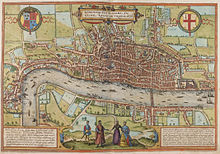London in the reign of the Tudor monarchs of England
The Tudor period in London started with the beginning of the reign of Henry VII in 1485 and ended in 1603 with the death of Elizabeth I. During this period, the population of the city grew enormously, from about 50,000 at the end of the 15th century[1] to an estimated 200,000 by 1603, over 13 times that of the next-largest city in England, Norwich.[2] The city also expanded to take up more physical space, further exceeding the bounds of its old medieval walls to reach as far west as St. Giles by the end of the period. In 1598, the historian John Stow called it "the fairest, largest, richest and best inhabited city in the world".
